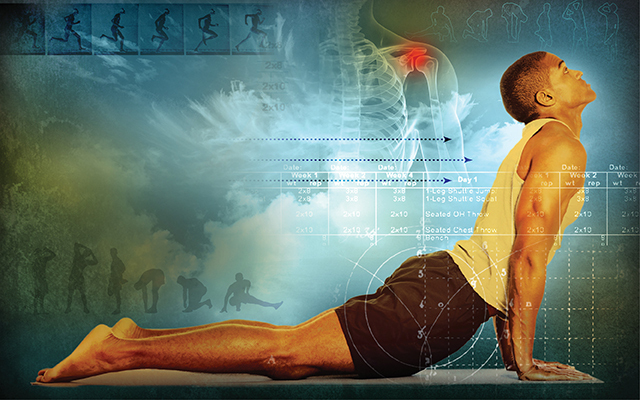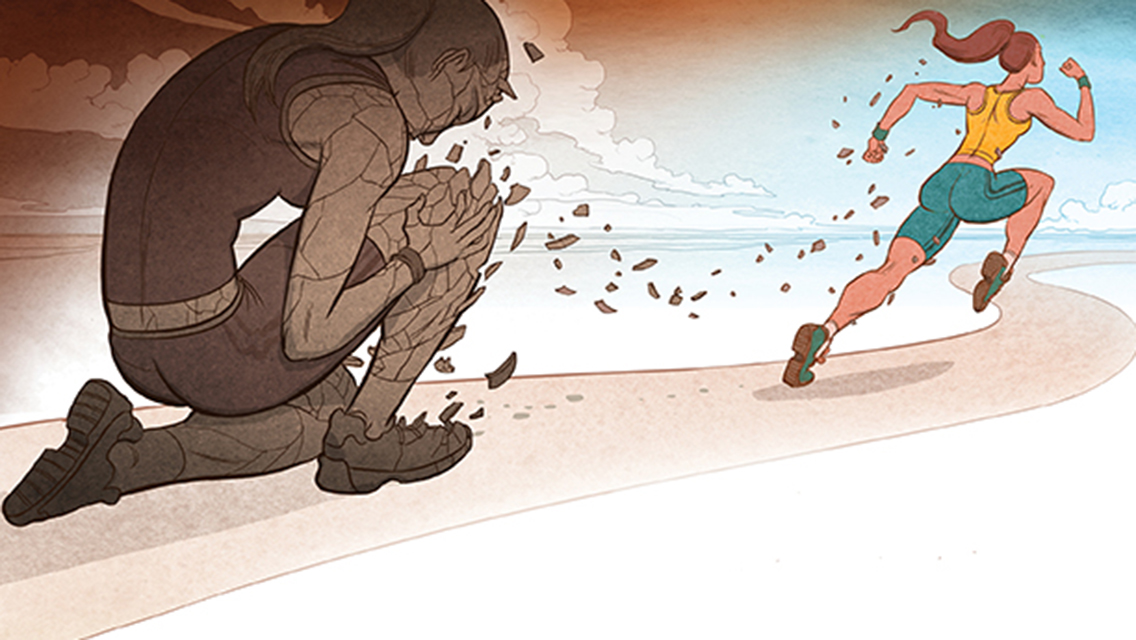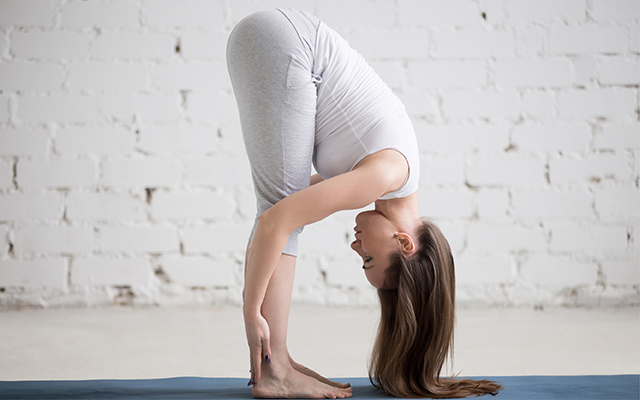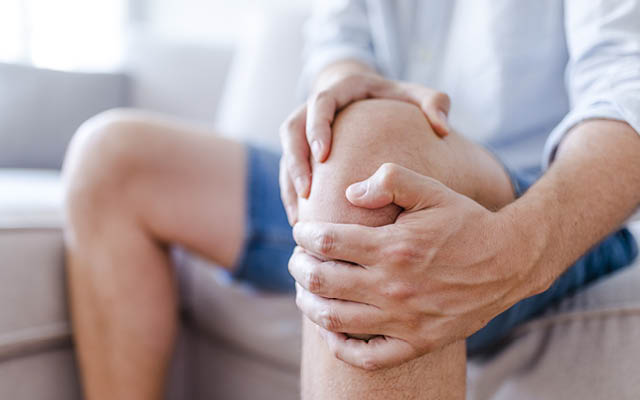The beginning of the end came three years ago while I was trail running on a muggy Pennsylvania summer evening. Somewhere amid an expansive, twisting set of mountain paths, I got lost. Really lost.
Five miles turned into seven, then 10. Foolishly, I’d brought only my car key. Worse, I hadn’t told anyone where I was. As the light began to fade, worry took hold. I ran faster, vaulting over tree roots and dashing off on one wrong turn after another, pushing myself beyond my normal limits.
Finally, to my great relief, I stumbled out of the trees, my legs and midsection burning. In the end, I’d run close to 18 miles, or two-thirds of a marathon. Without water. In high heat. Without any training. But hey, my body could handle it, I told myself. After all, it always did.
Like so many other recreational athletes in their mid-30s, I’d spent my life beating up my body. Three sports in high school. Two in college. Basketball and soccer leagues, flag football tournaments, marathon weekend tennis matches: If you could compete at it, I did it.
Some days I’d play two hours of basketball at lunch and then suit up for a league that night. Later, I added running, pounding my knees relentlessly.
And what did I do to preserve and maintain my body? Nothing. No stretching or strengthening or recovery. Sure, I lifted weights, but primarily to gain beach muscles, rotating through bench presses, curls, and the like.
Exercise was my drug. Two days without it, and I became itchy and grumpy.
There are physical reasons for my attachment to exercise, of course — the rush of endorphins brought on by exercise, the increased alertness, the myriad physiological benefits, such as a stronger immune system and increased sex drive. But there are also psychological ones. “For many athletes, sports provide a sense of identity,” says Alan Goldberg, EdD, who runs Competitive Advantage, a performance consulting firm in Amherst, Mass., and who was the sports psychology consultant to the 1999 NCAA champion University of Connecticut men’s basketball team. “They dictate how you see yourself and how others see you.” Sports are also a source of self-esteem, says Goldberg, and they provide a constructive, healthy way to cope with stress.
I relied on exercise for all this and more. And, up until that summer evening in my 37th year, it was all working out fine. Sure, I’d twisted ankles, tweaked knees, and strained hamstrings. But my body always bounced back, stronger than before.
Only this time it didn’t.
The pain began as a dull ache in my abdomen, flaring up when I ran or played basketball, the classic warning sign of an incipient sports hernia. At first, I tried the time-honored technique of ignoring it.
I say “time-honored” only half-jokingly. There is some evidence, both anecdotal and research-based, that ignoring a minor injury can be a useful strategy. And with common sports injuries, seeing a doctor doesn’t always help. On the contrary, doctors may just scare you away from your sport unnecessarily.
A 2010 study of 39 collegiate and professional hockey players found that more than 50 percent had labral tears in the hip, even though they weren’t in pain and it didn’t limit their ability to continue playing hockey.
There’s even evidence to suggest that just by being an athlete, you are better suited to endure the aches and pains of sports. In a 2012 meta-analysis conducted at the University of Heidelberg in Germany, researchers looked at 568 athletes and 331 nonathletes and found that while most people have the same pain threshold, athletes tend to have a higher tolerance for pain.
In my case, however, the burning feeling wasn’t going away, no matter how hard I tried to ignore it. Midway through a 10-mile trail race, I pulled up, my lower abdomen on fire. I had to walk the rest of the way, watching as all the runners I’d worked so hard to pass rushed by me. Making matters worse, my right shoulder had also begun bothering me, the result, I assumed, of years of overuse.
By the following spring, I was a physical wreck. Only 38, I was in full denial. I’d given up running and stopped playing tennis, lest I tweak my shoulder. I spent three months shooting the ball left-handed in basketball games, which neither helped my shoulder recovery nor endeared me to my teammates.
The low point came when I decided to rest. I stopped exercising for two months. I bought a treadmill on Craigslist and walked away my days. I gained weight because, of course, I still ate like an athlete. I was miserable — and with good reason.
“It’s demoralizing to get injured,” says Goldberg. “Most serious athletes are incredibly competitive. What they do is think about where they used to be and compare themselves with their teammates. When you do that, it’s a losing game.”
Not only was it demoralizing, but unbeknownst to me, I might have been doing my body a disservice by taking time off. Some experts believe that rest just for the sake of rest can, at times, be counterproductive. When you face a sports injury, says Jordan Metzl, MD, a sports-medicine physician at the Hospital for Special Surgery in New York City and coauthor of The Exercise Cure, you may need to avoid a specific sport while you heal, but that doesn’t mean sacking out on the couch. Instead, consider switching activities to anything that keeps your body in motion without putting you at risk for reinjury.
“My advice is not to do less activity,” says Metzl. “I believe in the value of exercise on a daily basis.”
The key, Metzl says, is to train differently. Since every person and every injury is different, it’s important to consult a doctor or healthcare provider before embarking on any new movement program. Metzl encourages patients to understand the body’s kinetic chain, or the way the muscles and joints are connected head to toe, and consider that for their workouts. One way to do this is through functional strength training with equipment such as kettlebells and balance boards, or by doing body-weight exercises. Another is to use foam rollers to repair and massage the body. Restorative movement, such as yoga or Pilates, can also be useful.
Me? I just kept doing the wrong things until, finally, a year and a half after that fateful trail run, I did something I should have done months earlier: I got help.
The pivotal moment came when I tried to play in a weekend basketball tournament but found myself so out of shape and limited by my injuries that 50-year-old guys were blowing by me. This was humbling, but also eye-opening. These guys were playing, and playing well, at 50. I wanted to do that too, and clearly that wasn’t going to happen unless I did something about it.
What I didn’t expect was that having a sports injury would end up changing my life for the better.
The first two doctors provided vague diagnoses. The third went overboard in the other direction. Early arthritis of the hip, he said. Severe and degenerative. This on top of either an abdominal strain or sports hernia and tears in my rotator cuff. I was shell-shocked. Batten the hatches and give up sports, the doc said. You’re done.
Not wanting to believe it, I sought out Matt Sheehy, MSPT, CSCS, a highly recommended San Francisco–based physical therapist who specializes in sports medicine. His schedule was packed. I soon learned why.
It took Sheehy all of 30 minutes to totally deconstruct me. He pulled on this, pushed on that, had me lie down, stand up, and squat. Then he broke the news. My injuries were only part of the issue. Despite all those years of exercising, I was a mess.
As a writer, even though I’d played all those sports, I’d also spent decades sitting at a computer. As a result, my hamstrings were weak. So was my core. All that tennis and lifting and basketball had created scar tissue everywhere, especially in my shoulder. My range of motion was deplorable. I’d done the equivalent of driving a car every day for years without ever getting an oil change or performing regular maintenance.
Sheehy prescribed an extensive physical-therapy routine. I’m not going to lie: It was rough. For an hour and a half every other day, I was in the gym doing negatives on the adductor machine, quivering through bridges, and using resistance bands for external shoulder rotations and air squats.
The whole thing was embarrassing. For years I’d joked about those people at the gym who never broke a sweat, who looked like they weren’t actually exercising. It was easy to feel superior to the guy slowly pedaling the stationary bike or holding goofy poses on the blue mats. Now I was one of them.
At one point, I was doing a 60-second shoulder stretch every 30 minutes during my waking hours. My iPhone timer would buzz and I’d start yanking on my elbow, regardless of whether I was at a coffee shop, a meeting, or, to my wife’s dismay, out to dinner. When we went on vacation, I did my strange routine in hotel rooms, a stiff, wobbly 30-something man in his undershirt squatting and stretching. My two young daughters thought it was hilarious to watch. It probably was.
It was also frustrating. I felt like I was losing ground, not gaining it. Explosive power, endurance, muscle mass — all dissipated by the day. According to Goldberg, I was having a common response. “If I’m working with any athlete who’s suffering through this, I try to keep them focused on the present,” says Goldberg. “There’s a tendency for athletes to dwell on what was, or might have been.”
Rather, once athletes have mourned their loss, they need to focus on rehabilitation, on turning their attention forward in a productive fashion, and on setting new, realistic goals. (See “Sports Injuries: The Mental Game,” below.)
In my case, as the months passed I found the rehab work becoming more bearable, even gratifying at times. Slowly but surely, I could feel my body getting stronger in areas I’d long ignored. I began listening to podcasts while I worked out, something I’d never been able to do during intense workouts, and found it provided a great sense of efficiency. I began biking more and getting out into the hills. Newly aware of the toll of sitting on my butt all day, I added a standup desk to my home office and began walking during long phone calls rather than slouching in a chair. When I did have to sit, I tried to assume better posture. Meanwhile, every month when I went back to see Sheehy, he gave me new exercises: planks, side planks, serratus pushups, prone Ys for shoulder-blade strength.
By month seven, I was making clear progress. My shoulder had loosened up. I was moving some serious weight on the adductor machine. I planked like a madman. I’d strengthened the core muscles around my abdominal strain enough that Sheehy gave me the green light to begin trail running again, though cautiously at first.
And that’s when a strange thing happened: I began to feel really good. As in better than before. I was lighter, and stronger through the middle. I felt better proportioned and livelier. I had a new appreciation for my body and what I could do with it.
Goldberg notes that this is a common phenomenon in patients who recover from injuries. He tells the story of a competitive swimmer who had shoulder surgery and missed nearly the whole season but lowered his time when he returned for the end-of-season championships. The reason: He’d spent all those months kicking harder than he ever had before. The increase in his leg strength outweighed the decrease in his shoulder strength. For the first time, and as a direct result of his injury, he valued what he had.
“We lack a certain maturity when we’re younger and are under the illusion that we can do whatever we want, and take for granted what we have,” explains Goldberg.
Most athletes focus on pushing themselves to do more. “They think, ‘If I work hard, I can do this,’” Goldberg says, rather than appreciating what they can already do, and what they have in the moment. “We don’t live in a culture that encourages that sort of gratitude,” says Goldberg. “It’s always about the goal. There’s a focus on the outcome. That’s how coaches and athletes measure success. We lose the appreciation of the dance. And that’s all there is in the end — the dance. Outcome isn’t worth a whole lot. It’s the process that matters.”
Fast-forward to the present day. At age 40, I love the process. I feel healthier than I have in a long time. Perhaps this is cognitive dissonance, but I don’t care. I’m smarter about my body. I’m taking care of it in ways I never did. I no longer consider my workouts to be “physical therapy.” They’re just great workouts. I intend to do planks and squats and shoulder stretches the rest of my life. I’m back to playing hoops regularly, and my performance is roughly on par with where I was before my injuries. I dunked again this year for the first time in a while.
In a weird way, I almost wish I’d gotten injured earlier in my life. I wonder what I might have been able to prevent.
I’m not alone. Metzl tore a knee ligament while in med school. “By 30, I was getting arthritis in my knee because I didn’t know how to strengthen it,” he says. “Once I learned about functional strength, I felt my body respond. I’m 46 now and I’m stronger than I was when I was 30.”
If I could advise my younger self, the one in his 20s barreling through life, I’d tell him to slow down every once in a while. To learn more about his body. To understand that just exercising isn’t enough. That 10 minutes of targeted shoulder exercises a week might save him years of pain. That sitting on a chair all day was shaving hours off his life and weakening his legs. I’d tell him to suck it up and go to a yoga class once, or learn about dynamic stretching. To put down the dumbbells and get off the bench press once a week and try something different.
But hey, there’s still time to do all that. And I’m feeling optimistic. My hip may be deteriorating, but I’m protecting it the best I can. I’ve taken as much control as possible of the situation, and there’s a real sense of progress.
Rarely as athletes — recreational or otherwise — do we feel like we’re getting better at anything after a certain age. Science tells us that our muscle mass decreases each year, that we lose fast-twitch fiber, that our bone mass diminishes. And it’s true, we can’t get younger.
But we can get smarter.
Sports Injuries: The Mental Game
Recovering from a sports injury requires more than just physical therapy; there’s also psychological healing. Sports psychologist Alan Goldberg, EdD, offers some strategies for dealing with an injury.
- Go ahead and be sad — at least at first. It’s important to mourn this loss, just like any other. There’s no need to be macho.
- Then, maintain a positive attitude. Once you shake off your feelings of sadness and loss, an optimistic outlook will speed the healing process while decreasing the emotional pain. Goldberg encourages his patients to repeat the mantra, “If it is to be, it is up to me.”
- Focus on “what is.” “Don’t play the ‘coulda, mighta game,’” says Goldberg. You’re injured. Accept it and move forward.
- Set new goals for yourself. They may be smaller at first, but that’s OK. The key is to make sure they’re achievable, and build up from there.
- Take an active part in your healing. Don’t cut corners. Don’t resist or resent your physical therapy. No one’s making you do this. The only person who loses when you loaf is you.
- Continue to practice and work out. Even if you’re temporarily sidelined, you can visualize playing your sport. Goldberg calls this “improving your headset.” A huge part of sports is mental, after all.
- Seek out the support of your teammates. You’ll be tempted to isolate yourself. Don’t do it. Show up to that rec-league hoops game just for the camaraderie. Meet your running or biking group when they grab coffee or a beer at the end of their workout. The connection and inspiration are important.
For more on recovering from injury, see “Give It a Rest” and “Facing Down an Injury”.




This Post Has 0 Comments